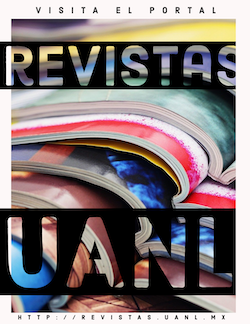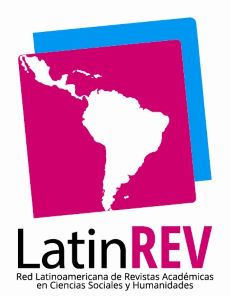Cincuenta años de enseñanza de la ciencia criminológica en la UANL
DOI:
https://doi.org/10.29105/cc5.8-112Palabras clave:
Criminología, Prevención, Privación de la libertad, Víctima, Exclusión socialResumen
La enseñanza de la ciencia criminológica cumplió cincuenta años como institución pionera y actual referente.
En este número, se presentan trabajos de investigación que, una vez más, se plantean problemas sociales que, estudiados desde la criminología, se aproximan a soluciones. En efecto, estudios dirigidos a sectores poblacionales olvidado o invisibles pero que son objeto de atención para los científicos de la criminología.
Descargas
Citas
Arriaga-Avalos, L. D., Montaño-Borboa, I. d., & Quintero-Avila, O. (2023). La dimensión subjetiva del estado de seguridad en polígonos de la zona metropolitana del Estado de Nuevo León, México. Dilemas contemporáneos: Educación, Política y Valores, 11(1), 1-23. DOI: https://doi.org/10.46377/dilemas.v11i1.3827
Arriaga-Avalos, L. D., Quintero-Avila, O., & Montaño-Borboa, I. d. (2022). Una visión criminológica de la percepción de seguridad en “Barrio antiguo”, centro de Monterrey, Nuevo León. Dilemas contemporáneos: Educación, Política y Valores, 9(1), 1-27. DOI: https://doi.org/10.46377/dilemas.v10i1.3299
García, V. J. (2022) b. Cibercriminología, la Criminología de la Nueva Era. Expresion Forense, 06-11.
García, V. J. (2023) c. Victimización, polivictmización y ¿revictimización? Nuevo Mundo. Estrategia organizacional bajo un nuevo enfoque cognoscitivo, 56-60.
Hikal, W. (2009). Ciencia y sociedad. Recuperado el 26 de mayo de 2023.
Martínez, A. (2016). Factores de riesgo de la conducta antisocial en menores en situación de exclusión social [tesis de doctorado, Universidad Complutense de Madrid].
Mora, M. y Oliveira, O. (coords.) (2014). Desafíos y paradojas: los jóvenes frente a las desigualdades sociales. El Colegio de México.
OMS (2002). Informe Mundial sobre la Violencia y la Salud. OMS, Ginebra.
Serrano, M. (2014). Exclusión social y criminalidad. Revista de Derecho UNED, (14), 587-617. DOI: https://doi.org/10.5944/rduned.14.2014.13312
Téllez, M. y Rivera, L. (2020). Construcción y validación de un instrumento para medir la percepción de exclusión social en jóvenes. Psicogente, 23(43), 144-166. DOI: https://doi.org/10.17081/psico.23.43.3294
Uceda, F. y Domínguez, J. (2016). Vinculación entre la vulnerabilidad y la exclusión social y las trayectorias delictivas. Un estudio de asociación. Psychosocial Intervention, (26), 29-37. DOI: https://doi.org/10.1016/j.psi.2016.07.003
Descargas
Publicado
Cómo citar
Número
Sección
Licencia
Derechos de autor 2025 José Zaragoza Huerta, Gil David Hernández Castillo, Paris Alejandro Cabello Tijerina

Esta obra está bajo una licencia internacional Creative Commons Atribución-NoComercial 4.0.
Los autores/as que publiquen en esta revista aceptan las siguientes condiciones:
a. Los autores/as conservarán sus derechos de autor y garantizarán a la revista el derecho de primera publicación de su obra, el cual estará simultáneamente sujeto a la Licencia Creative Commons Atribución-NoComercial 4.0 Internacional. que permite a terceros compartir la obra siempre que se indique su autor y su primera publicación esta revista.
b. Los autores/as pueden realizar otros acuerdos contractuales independientes y adicionales para la distribución no exclusiva de la versión del artículo publicado en esta revista (p. ej., incluirlo en un repositorio institucional o publicarlo en un libro) siempre que indiquen claramente que el trabajo se publicó por primera vez en esta revista.
c. Se permite y recomienda a los autores/as a publicar su trabajo en Internet (por ejemplo en páginas institucionales o personales) posterior al proceso de revisión y publicación, ya que puede conducir a intercambios productivos y a una mayor y más rápida difusión del trabajo publicado (Véase El efecto del acceso abierto).










 Constructos criminológicos Vol. 5 Núm. 9, Julio-Diciembre 2025, es una publicación semestral editada por la Universidad Autónoma de Nuevo León, a través de la Facultad de Derecho y Criminología. Dirección de la publicación: Av. Universidad s/n Cd. Universitaria C.P. 66451, San Nicolás de los Garza, Nuevo León, México.constructoscriminologicos.uanl.mx, constructoscriminologicos@uanl.mx. Editor responsable: Dr. José Zaragoza Huerta, Facultad de Derecho y Criminología. Reserva de Derechos al Uso Exclusivo núm. 04-2024-110717414100-102 ISSN 2954-5234, ambos otorgados por el Instituto Nacional del Derecho de Autor. Responsable de la última actualización: Dr. José Zaragoza Huerta, Facultad de Derecho y Criminología Av. Universidad s/n Cd. Universitaria C.P. 66451, San Nicolás de los Garza, Nuevo León, México. Fecha de la última modificación 10 de julio 2025.
Constructos criminológicos Vol. 5 Núm. 9, Julio-Diciembre 2025, es una publicación semestral editada por la Universidad Autónoma de Nuevo León, a través de la Facultad de Derecho y Criminología. Dirección de la publicación: Av. Universidad s/n Cd. Universitaria C.P. 66451, San Nicolás de los Garza, Nuevo León, México.constructoscriminologicos.uanl.mx, constructoscriminologicos@uanl.mx. Editor responsable: Dr. José Zaragoza Huerta, Facultad de Derecho y Criminología. Reserva de Derechos al Uso Exclusivo núm. 04-2024-110717414100-102 ISSN 2954-5234, ambos otorgados por el Instituto Nacional del Derecho de Autor. Responsable de la última actualización: Dr. José Zaragoza Huerta, Facultad de Derecho y Criminología Av. Universidad s/n Cd. Universitaria C.P. 66451, San Nicolás de los Garza, Nuevo León, México. Fecha de la última modificación 10 de julio 2025.